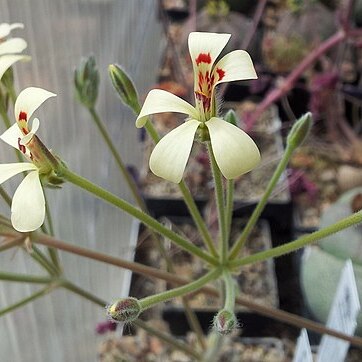A deciduous geophyte with a regularly shaped subterranean tuber, 120-200 mm tall when in flower. Tuber: a turnip-shaped or elongated, sometimes moniliform root with a short flattened stem, covered with flaking dark-brown periderms, 30-80 mm long and 12-30 mm in diameter. Leaves radical, hysteranthous, rosulate, simple or ternate, green, petiolate; lamina ovate, apex acute, margin entire to serrate, revolute, 25-95 x 14-48 mm, adaxially and abaxially hirsute or sparsely hirsute with stiff hairs interspersed with short glandular hairs and long soft non-glandular hairs; petiole 25-90 mm long and 1-3 mm in diameter, prostrate, densely hirsute with short appressed hairs and sparsely interspersed with short glandular hairs; stipules subulate, adnate to petioles with apices free, 5 mm long and ±1 mm wide, ciliate. Inflorescence: scape 10-70 mm long, 1-3 mm in diameter, branched, bearing 2-4 pseudo-umbellets with 3-8(-11) flowers each; peduncles 35-85 mm long, 1-2.5 mm in diameter, densely hirsute with distally appressed curly hairs interspersed with long glandular hairs; bracts lanceolate, 4-8 mm long, 1.5-2 mm wide, abaxially hirsute with distally appressed hairs interspersed with glandular hairs; flower buds, flowers and fruits erect. Pedicel ca. 0.5 mm long. Hypanthium 33-66 mm long, pale green, indumentum as on peduncle, hypanthium/sepal ratio 4-10. Sepals 5, lanceolate, apices acute, 6.5-11 mm long, 1.5-3 mm wide, posterior one erect, others reflexed, green to pale reddish brown with margins white, indumentum abaxially as on peduncle. Petals 5, cream-coloured to yellow, claws forming a sheath; posterior two with wine-red feather-like markings, unguiculate-spathulate, bases cuneate, apices emarginate, 14-25 x 3.5-6 mm, length/width ratio smaller than 5.5; anterior three spathulate, bases attenuate, apices rounded, 12-20 x 3-5 mm. Stamens 10, basally connate, staminal column 1.5-2 mm long, white; perfect stamens 5, concealed within the floral sheath, posterior one 2-3.5 mm long, lateral two 3-4.5 mm long, anterior two 4-7 mm long, white; staminodes 2.5-3 mm long; anthers pink, 1.5-2 mm long, pollen orange. Gynoecium: ovary superior, oblong-conical, 5-lobed, 2.5-4 mm long, densely sericeous; style filiform, 0.5-2 mm long, pale green; stigma with 5 recurved branches, 1-2 mm long, adaxially wine-red. Fruit: a schizocarp consisting of 5 mericarps, bases of mericarps ±7 mm long, with glandular hairs, tails ±36 mm long. This species has an apparent long flowering season, from September-December, which is due to the irregular start of the raining season. Sometimes leaves are still present when flowering time starts, but often flowers appear after the leaves have died.
More
Deciduous geophyte, up to 0.2 m high; tuber subterranean, turnip-shaped or elongated. Leaves radical, rosulate, hysteranthous, simple or ternate; lamina ovate, apex acute, margins entire to serrate, revolute 25-95 x 14-48 mm; adaxially and abaxially hirsute with stiff hairs interspersed with long, soft hairs and short glandular hairs; petioles 25-90 mm long. Inflorescence a scape 10-70 mm long, branched, bearing 2-4 pseudo-umbels with 3-8 flowers each; peduncle 35-85 mm long. Hypanthium 33-66 mm long. Sepals 5, lanceolate. Petals 5, cream-coloured to yellow, posterior 2 with red markings, unguiculate-spathulate; anterior 3 spathulate. Stamens 10; perfect stamens 5; staminodes 5; anthers pink; pollen orange. Flowering time Sept.-Dec. Fruit a schizocarp of 5 mericarps.

